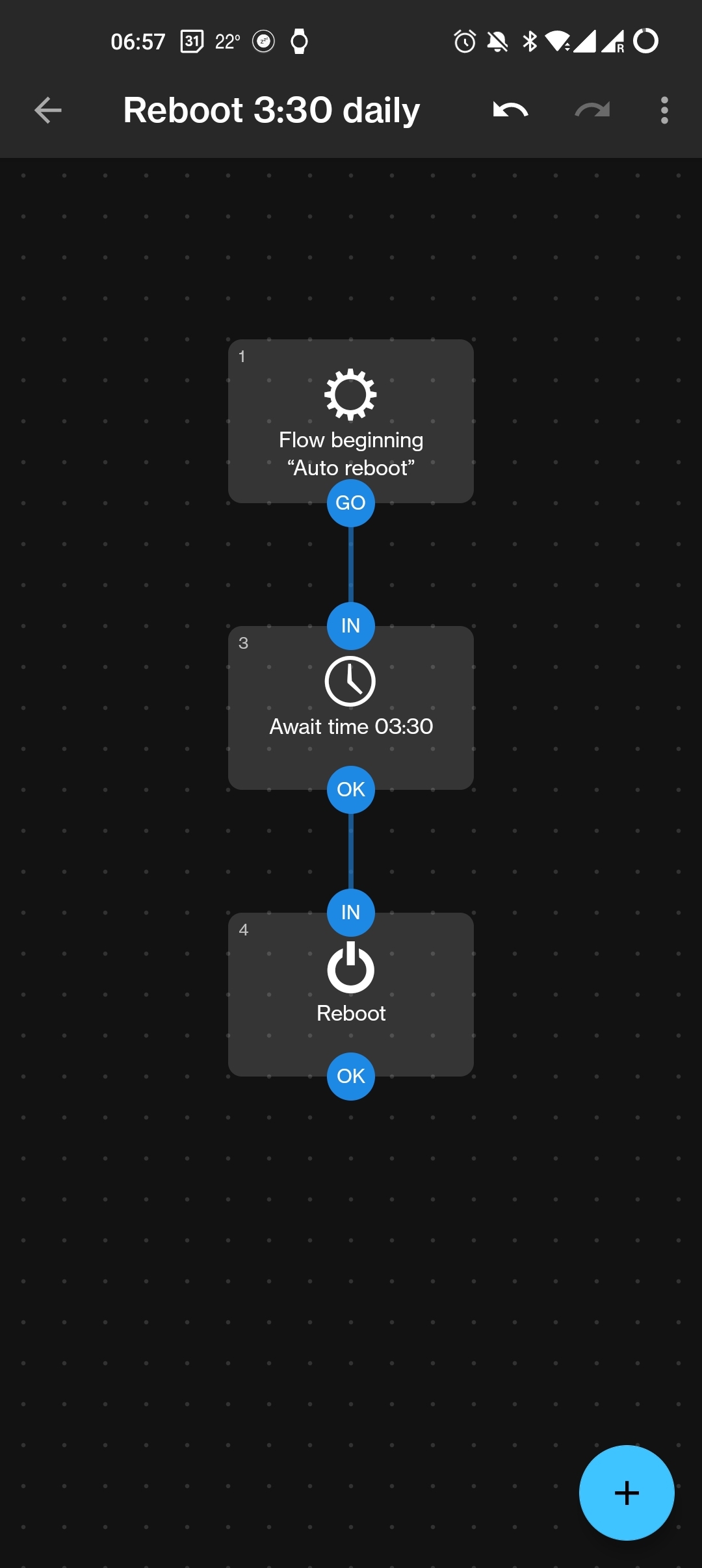You do it because it makes an attacker’s life harder because now I have to find two bugs instead of one.
The entire boot chain of the phone up to the apps you run are verified successively by the component that loads it. A digital signature helps ensure that only trustworthy code ever runs. A bug must be found to bypass these checks to load malware code. For example, a bug in the image code in a web browser might cause loading of code that isn’t checked. This way the malware gets smuggled onto the phone.
This means that if you get hacked via one bug and malware is loaded, the attacker has to work harder to solve the problem of how do I convince the phone to load it again at boot because the code it’s made of isn’t going to be approved code. When you reboot, you are effectively forcing a validation that all the code you have running is authentic, which would exclude the malware. Trick me once sure, can you survive a full pat down? Probably not. It’ll get caught.
Unless I have a second bug to fool the normal code loading systems too, the malware can’t run. You have to go back and trigger the first bug again somehow, which places more strain on the attacker.
Thanks for taking the time to write that out. I found it really helpful.👍
I love to talk about computer security. I don’t get the chance often enough.
I hope you get more chances to do so; you explained the situation in a much better way than the article and convinced me to reboot my phone.
You restart your phone because of security.
I ‘restart’ my phone, because it’s overheated and lost its battery % to 0.
We’re not the same.
I hope to hear you* on Darknet Diaries hahaha
Thank you, friend. You’ve convinced me to restart my phone.
Exactly, as you already explained in detail this is primarily for security.
GrapheneOS has a feature to set a time after which the phone reboots in case there was no unlock. So in case a bad actor gets your phone they only have that time with a running system after the first unlock. However, if you use it normally, and unlock it in regular intervals it does not auto-reboot. This is especially neat if your threat level is not “investigative journalist” or “political activist on the run”, because then you can set the time to a longer interval and the phone does not reboot every night when you are asleep which also leads to the SIM card being locked and nobody being able to call you…
I remember this feature, and I wish it was a standard Android feature. It sounds like it would be trivial to implement and could be completely optional.
I wonder if tasker could do it… 🤔
I don’t think applications can reboot the phone.
Technically they can…but it requires root which within the context of this conversation yeah, you’re right, lol
I miss my BlackBerry and it’s scheduled reboot option
Pixels with grapheneos can reboot automatically after a number of hours with the screen off (unattended because you are sleeping). But this would also interfere with Whatsapp backup, which happens overnight.
Samsung phones also have a reboot schedule option
Where?
Settings > Device care > Auto optimization > Auto restart
But that only works for untrusted code escaping a sandbox, right? It does not help with malicious code embedded into legitimate seeming apps. The later vector seems easier, especially on Android, no?
I don’t really consider a malicious app to be an exploit. In this case, the software is doing exactly what it was designed to do – malicious activity. It’s not being manipulated to perform unintended operations through the exploitation of a software bug. Code signing and secure boot are not effective in the face of intentionally shipping malicious code to end users. It’s designed to frustrate actual hackers.
For malicious-by-design apps, we rely on a central app store that hopefully reduces the number of bad apps in circulation. If you publish malware, eventually you get caught and we know who you are. Sandboxing with a permissions system helps prevent apps from performing actions contrary to the user’s interests. E.g. why is my flashlight app asking for my contacts when I pressed ‘change color?’
If you directly exploit your way in, it’s harder to know who did this and why because you didn’t go through any central vetting or accountability system, and you’re not so easily bound by the permissions system. It depends on what your bad guy’s goals are, what they want, whom they’re targeting. Force your way in the back entrance, crawl through an open window (like a weak security setting), or lie your way in the front door (trojan)? It depends.
None of it is perfect, but I’m sure OS design experts would love to hear about better solutions if any exist.
Your explanations really are poetry.
Aww, thank you!
Guessing Pegasus and their ilk have an easy way around this
Nope! From Kaspersky:
Reboot Daily: According to research from Amnesty International and Citizen Lab, Pegasus often relies on zero-click 0-days with no persistence. Regular daily reboots can help clean the device, making it necessary for attackers to repeatedly reinfect, thereby increasing the chances of detection over time.
For a case with persistence, Lookout notes another bug was required and details the extra work.
Jokes on them, my S22 Ultra restarts in it’s own. Even when I don’t want it to.
It’s a feature! Device Failed Successfully.
Sounds like my wife’s old Samsung phone as well… I’m sensing a common theme…
This is gonna sound odd, but have you cleaned out the USB port lately? Weird stuff happens when pocket lint collects in there. I thought mine had a dead port until I picked out (with a non-conductive toothpick) the lint I didn’t realize had accumulated.
Replace your battery.
Your phone is 2 years old.
Phone batteries are typically designed to last around 2 years before they really degrade because a lot of people buy new ones around every 2-3 years.
When the battery can’t sustain the same throughput, the phone can handle this in one of two ways.
-
Slow the phone down. This is what Apple does and why people with iPhones 2 years old complain the new update slowed their phone down.
-
Don’t slow it down but if the throughput drops below what’s needed, die and reboot. This is what your phone is doing.
Getting a new battery will probably stop this behavior (and for iPhone users reading this, getting a new battery for a 2 year old phone will make your phone faster).
-
TL;DR:
Restarting your phone once a week can help improve performance and security.- this is the same for routers and it’s commonly known as a power refresh
Maybe home grade routers.
If my router rebooted once a week, it would be in the trash can.
I wonder if the regular updates mine does count.
Yes, a reboot is a reboot. As long as the boot sequence cycles through where the code is validated, you’re good.
a reboot is a reboot
Not always. Some phones will do a sort of “soft” reboot, which doesn’t actually go through the entire boot process, but is more like logging out of the active OS user and back in, reloading some of the OS but not all.
Pretty sure a system update would trigger a full reboot, though, but I’ve seen the option for this sort of partial reboot in the power menu on some devices in the past.
Feels like I need to reboot my iPhone daily in order to keep applications and tabs from being terminated from out of memory issues as quickly.
I remember my old phone had the option to auto reboot and I had it set to like 3am but now I don’t see that option on newer phones. My previous phone didn’t even have a reboot option I had to shut it down and power it back up
I’m using Automate for this purpose, it’s a very simple flow:

https://play.google.com/store/apps/details?id=com.llamalab.automate
For Samsung phones. Go to Settings -> Device Care -> Under Performance you will see Auto Optimization -> At the bottom of the page you will see Auto Restart -> Restart on Schedule -> Done.
Would alarms work after a restart if I don’t unlock ot first?
For iOS they do; I would assume for Android they will as well. It would be pretty bad if an automatic update stopped you from waking up in the morning…
I’ve noticed my phone doesn’t initialize anything until I unlock it then it takes a while for it to boot up and all that but also I haven’t seen it reboot on its own, it usually gives you a prompt
I’ve tested this and they do still work
Wait…the NSA did something good. WTF.
Coming from the 9000 series, I am wondering what do you like about the 5700 series HAL?
“you do need to restart your phone regularly to rid it of demons”
typo: “daemons”, not “demons”.
GrapheneOS has an option to restart the phone after a given time without any successful unlock. I have it set to 8 hours, so it reboots every night. Shorter is possible.
A freshly restarted phone is in its safest state. Necessary to input the unlock code, strict minimum required processes running in the background.
finaly the nsa doesn’t do something stupid
I’d love to see your list of “stupid” things… not immoral, vicious, incendiary, criminal, etc…but stupid. None of those things is stupid if they are also your fundamental mandate.
✨ Us government instance discovered ✨
This is the best summary I could come up with:
Forbes uncovered a seriously dated NSA document outlining the best practices for keeping your phone safe from bad actors in the digital space.
The phones depicted are a 2010s-era iPhone with the original push-button Home button and a Samsung Galaxy smartphone.
Over a dozen tips are included, ranging from “considering using Biometrics” to “only use original charging cords.” It’s all fundamental stuff you’ve seen before, but the advice that’s got everyone’s ears perked up is the NSA’s suggestion to power your device off and back on weekly.
It’s a simple way to either force a waning software update or clear any background apps and memory leaks that might contribute to a too-hot-too-handle metal phone.
I’m a frequent restarter because I have cell signal issues in my area—a quick reboot usually does the trick, though not without my heart beating rapidly as I wait to see those mobile service bars return.
The Google Pixel doesn’t have a scheduled offering, but there is an option you can toggle on to have the device automatically restart once it receives an over-the-air (OTA) software update.
The original article contains 314 words, the summary contains 181 words. Saved 42%. I’m a bot and I’m open source!
I use Tasker automation that reminds me to reboot after my phone has been up for awhile. I don’t think I’d like an auto reboot feature. I don’t even like it when I can’t postpone a software update until a time convenient for me.
















